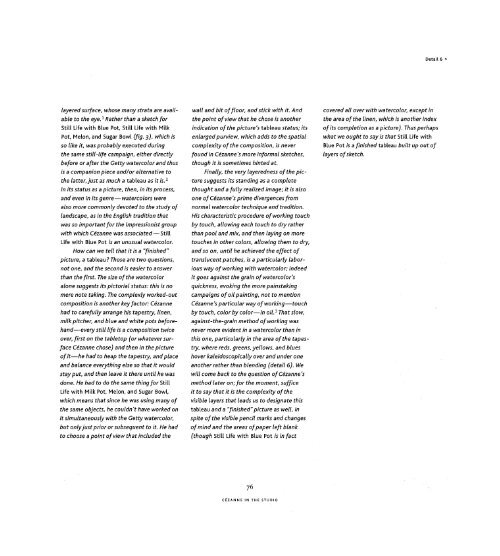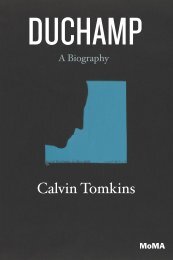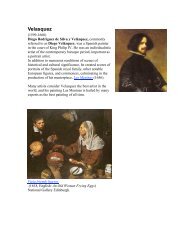Still Life in Watercolors
qbj8dgc
qbj8dgc
- No tags were found...
Create successful ePaper yourself
Turn your PDF publications into a flip-book with our unique Google optimized e-Paper software.
Detail 6 ><br />
layered surface, whose many strata are available<br />
to the eye. l Rather than a sketch for<br />
<strong>Still</strong> <strong>Life</strong> with Blue Pot <strong>Still</strong> <strong>Life</strong> with Milk<br />
Pot, Melon, and Sugar Bowl (fig. 3), which is<br />
so like it, was probably executed dur<strong>in</strong>g<br />
the same still-life campaign, either directly<br />
before or after the Getty watercolor and thus<br />
is a companion piece and/or alternative to<br />
the latter, just as much a tableau as it is. 2<br />
In its status as a picture, then, <strong>in</strong> its process,<br />
and even <strong>in</strong> its genre—watercolors were<br />
also more commonly devoted to the study of<br />
landscape, as <strong>in</strong> the English tradition that<br />
was so important for the Impressionist group<br />
with which Cézanne was associated — <strong>Still</strong><br />
<strong>Life</strong> with Blue Pot is an unusual watercolor.<br />
How can we tell that it is a "f<strong>in</strong>ished"<br />
picture, a tableau? Those are two questions,<br />
not one, and the second is easier to answer<br />
than the first. The size of the watercolor<br />
alone suggests its pictorial status: this is no<br />
mere note tak<strong>in</strong>g. The complexly worked-out<br />
composition is another key factor: Cézanne<br />
had to carefully arrange his tapestry, l<strong>in</strong>en,<br />
milk pitcher, and blue and white pots beforehand—every<br />
still life is a composition twice<br />
over, first on the tabletop (or whatever surface<br />
Cézanne chose) and then <strong>in</strong> the picture<br />
of it—he had to heap the tapestry, and place<br />
and balance everyth<strong>in</strong>g else so that it would<br />
stay put, and then leave it there until he was<br />
done. He had to do the same th<strong>in</strong>g for <strong>Still</strong><br />
<strong>Life</strong> with Milk Pot, Melon, and Sugar Bowl,<br />
which means that s<strong>in</strong>ce he was us<strong>in</strong>g many of<br />
the same objects, he couldn't have worked on<br />
it simultaneously with the Getty watercolor,<br />
but only just prior or subsequent to it. He had<br />
to choose a po<strong>in</strong>t of view that <strong>in</strong>cluded the<br />
wall and bit of floor, and stick with it. And<br />
the po<strong>in</strong>t of view that he chose is another<br />
<strong>in</strong>dication of the picture's tableau status; its<br />
enlarged purview, which adds to the spatial<br />
complexity of the composition, is never<br />
found <strong>in</strong> Cezanne's more <strong>in</strong>formal sketches,<br />
though it is sometimes h<strong>in</strong>ted at.<br />
F<strong>in</strong>ally, the very layeredness of the picture<br />
suggests its stand<strong>in</strong>g as a complete<br />
thought and a fully realized image; it is also<br />
one of Cezanne's prime divergences from<br />
normal watercolor technique and tradition.<br />
His characteristic procedure of work<strong>in</strong>g touch<br />
by touch, allow<strong>in</strong>g each touch to dry rather<br />
than pool and mix, and then lay<strong>in</strong>g on more<br />
touches <strong>in</strong> other colors, allow<strong>in</strong>g them to dry,<br />
and so on, until he achieved the effect of<br />
translucent patches, is a particularly laborious<br />
way of work<strong>in</strong>g with watercolor; <strong>in</strong>deed<br />
it goes aga<strong>in</strong>st the gra<strong>in</strong> of watercolor's<br />
quickness, evok<strong>in</strong>g the more pa<strong>in</strong>stak<strong>in</strong>g<br />
campaigns of oil pa<strong>in</strong>t<strong>in</strong>g, not to mention<br />
Cezanne's particular way of work<strong>in</strong>g—touch<br />
by touch, color by color—<strong>in</strong> oil. 3 That slow,<br />
aga<strong>in</strong>st-the-gra<strong>in</strong> method of work<strong>in</strong>g was<br />
never more evident <strong>in</strong> a watercolor than <strong>in</strong><br />
this one, particularly <strong>in</strong> the area of the tapestry,<br />
where reds, greens, yellows, and blues<br />
hover kaleidoscopically over and under one<br />
another rather than blend<strong>in</strong>g (detail 6). We<br />
will come back to the question of Cezanne's<br />
method later on; for the moment, suffice<br />
it to say that it is the complexity of the<br />
visible layers that leads us to designate this<br />
tableau and a "f<strong>in</strong>ished"picture as well, <strong>in</strong><br />
spite of the visible pencil marks and changes<br />
of m<strong>in</strong>d and the areas of paper left blank<br />
(though <strong>Still</strong> <strong>Life</strong> with Blue Pot is <strong>in</strong> fact<br />
covered all over with watercolor, except <strong>in</strong><br />
the area of the l<strong>in</strong>en, which is another <strong>in</strong>dex<br />
of its completion as a picture). Thus perhaps<br />
what we ought to say is that <strong>Still</strong> <strong>Life</strong> with<br />
Blue Pot is a f<strong>in</strong>ished tableau built up out of<br />
layers of sketch.<br />
76<br />
CÉZANNE IN THE STUDIO




